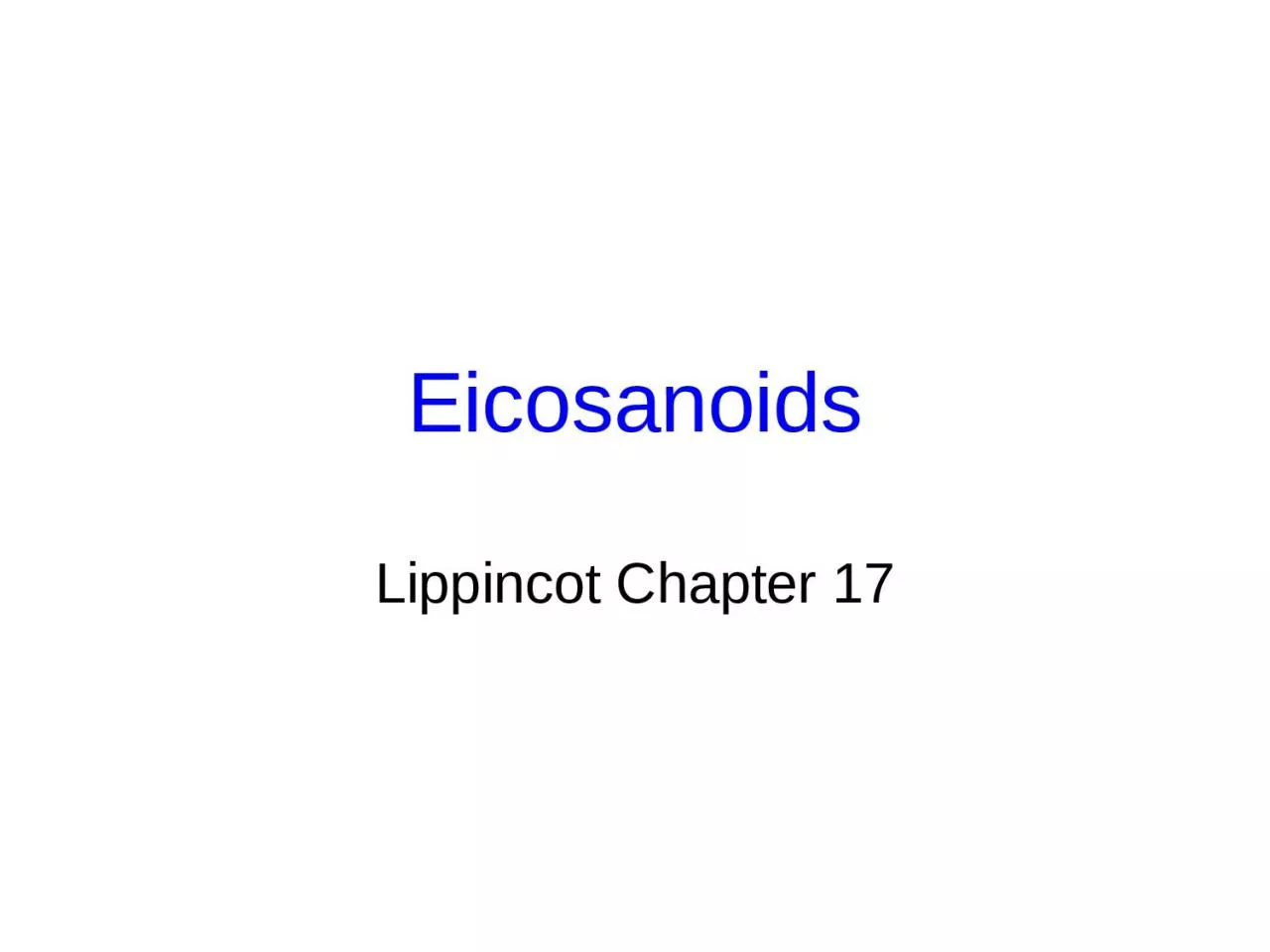

Eicosanoids Several Classes of Signal Molecules P rosta g landins Thromboxanes Leukotrienes Produced In Almost all Tissues Wide Range of Responses Local Hormones Very Potent Short Half Life ID: 916985
Download Presentation The PPT/PDF document "Eicosanoids Lippincot Chapter 17" is the property of its rightful owner. Permission is granted to download and print the materials on this web site for personal, non-commercial use only, and to display it on your personal computer provided you do not modify the materials and that you retain all copyright notices contained in the materials. By downloading content from our website, you accept the terms of this agreement.
Slide1
Eicosanoids
Lippincot Chapter 17
Slide2Eicosanoids
Several Classes of Signal Molecules:
Prostaglandins, Thromboxanes, LeukotrienesProduced In Almost all TissuesWide Range of ResponsesLocal HormonesVery PotentShort Half Life secondssNot Stored When needed they synthesized and released
The name eicosanoids was derived from eicosa which means 20 because the structure of all those molecules contains 20 carbons
The first class discovered was named prostaglandin because it was isolated from prostate, . Later it was found in other tissues as well. The other classes were shown to share some properties with PG
They are not transported in blood as in hormones, but act locally. Affecting the cells in the neighborhood of the secreting cells
Slide3Prostaglandin
Leucotriene
Thromboxane
What is this
?
Arachidonic Acid
Charactarized by 5 membered ring and two side chains attached to it.
(7 and 8 carbons) 1-3 double bonds in the chains.
Linear (no ring) charatarized by having 3 conjugated (alternating single-double) double bonds
All three classes are contain carboxyl group
Slide4Functional Groups on the Cyclopentane Ring Determine PG Class
Just have a look at the functional groups
. You are not expected to recognize each class
Slide5E
2
F
2
I2A2A4
The number in the name is the number of double bonds in the linear portion of the molecule.
Slide6Some Functions of the Prostaglandins and Thromboxanes
PGI
2
, PGE2, PGD2Increase - Vasodilation, cAMPDecrease - Platelet Agregation - Leucocyte Aggregation - Lymphocyte Migration
PGF2α Increses - Vasoconstriction - Bronchoconstriction - Smooth Muscle ContractionThromboxane Increases - Vasocostriction - Platelet Agregation - Lymphocyte Proliferation - Bronchoconstriction
Diversity of functions. Mostly affecting smooth muscles, leucocytes and platelets. You are not expected to memorize the functions.
You are not expected to memorize the functions. Just be familiar wit them. Notice that some have opposite effects
Slide7Overview of Eicosanoid Synthesis
Dietary Linoleic Arachidonic Acid
Membrane Phospholipids Arachidonic Acid PGH2 Prostaglandins Thromboxanes
Phospholipase A
2
Leukotrienes
HETE
The second fatty acid in the phospholipid is usually unsaturated. The second fatty acid is hydrolyzed by phospholipase A2.
This the rate limiting step in eicosanoids synthesis
Slide8Prostaglandin G (PGH) is the first product. Contains this peroxide
The peroxide is rapidly reduced to hydroxyl group to produce PGH which is the parent compound for other prostaglandins and thromboxane
Slide9C
yclo
ox
ygenase Complex (
COX) 1- Cyclooxygenase 2- Peroxidase
PGH is the Parent Compound for other Prostaglandins, Thromboxanes and Prostacyclin
Cycloxygenase that catalyzes the first step contains two activities. Cycoloxgease and peroxidase
Slide10Eicosanoids Can be Synthesized from other Polyunsaturated Fatty Acids
Arachidonic Acid (Eicosatetraenoic acid)
PG
2
Arachidonic acid has 4 double bonds. It produces PG2. ( 2 double bonds in the side chains)
Slide11Eicosapentaenoic Acid
E
icosa
p
entanenoic
acid (EPA)has 5 double bonds. It produces PG3. (3 double bonds in the side chains)
Some of the 3 series have opposite effect .than 2 series Thromboxane B3 produced from EPA inhibit platelets aggregation. May protect from myocardial infarction
Slide12Eicosatrienoic Acid
Eicosatrienoic acid has 5 double bonds. It produces PG1. ( 1 double bonds in the side chains)
Slide13Inhibition of Prostaglandin Synthesis
Steroidal Anti Inflamatory
Phospholipase A2Nonsteroidal Anti Inflamatory Aspirin; Acetylation of Cyclooxygenase or Irreversible Binding to the Enzyme
Slide14Aspirin transfers acetyl group to the active site of cycloxygenase inhibiting it
This the basis for using low dose aspirin to prevent thrombosis by inhibiting thromboxane synthesis.
Slide15C
yclo
ox
ygenase exists in two FormsCox 1ConstitutiveGastric Mucosa, Kidney, PlateletesCox 2 - Inducible; in Response to inflamation signals - Monocytes, Macrophages, Smooth Muscle
Slide16Inactivation of Prostaglandins
Rapid
Oxidation of Hydroxyl group at C15
Reduction of Douple bond at C13
Slide17L
euko
t
rienes and (LT) Hydroxyeicosatetraenoic acid(HETE)Signal MoleculesProduced from Arachidonic AcidLinear Molecules; No RingLT Contain 3 Conjugated Double Bonds
Slide18Lipooxygenase Catalyzes the First Step
Arachidonic Acid
Lipooxygenase
H
ydro
P
eroxy
e
icosa
t
etra
e
noic Acid
Slide19Slide20